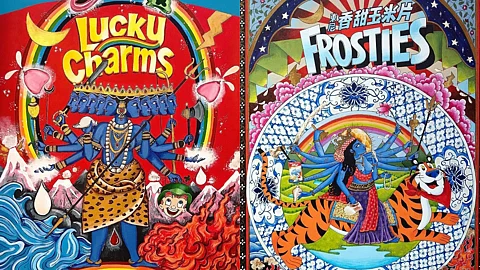
- HOMEGROWN WORLD
- #HGCREATORS
- #HGEXPLORE
- #HGVOICES
- #HGSHOP
- CAREERS
- ABOUT US
- CONTACT US

Hong Kong-based Riya Chandiramani is a visual artist that is known for her powerful 'Cereal' series. The series includes cereal boxes painted with depictions of masculinity, femininity, gender, sexuality and patriarchy. A pastiche of traditional and pop-culture references, Riya's cereal boxes are agents of social commentary born from a culturally rich perspective informed by both the experience of facing and healing trauma through reflective artistic expression.
Riya's imagery is a fusion of Western branding, and Indian and Chinese cultural art and is representative of her lived experience as a Hong Kong-born Indian woman with an international upbringing. Having struggled with a serious eating disorder at university, the artist was forced to question the societal conditioning and stigmatization that women experience surrounding their bodies. This influenced her practice which portrays the themes of nourishment, the female body, power and the oppressive hold of capitalism that uses insecurity and 'flaws' as a currency.
In her final year, the artist wrote a thesis on masculinity, appalled at the behaviour of young men on US college campuses in recent years. It made her realize that not unlike women, the definitions for how men should be 'masculine' are extremely limiting and oppressive. And gave her an insight into gender equality which extends beyond basic rights and breaking boundaries for women, into the very fabric of identity and the constructs that prevent people from being their true selves.
As a woman, Riya had always been bothered by the restrictions imposed on here every time she would visit her family in India; to not be able to go alone where she wanted and wear what she wanted. She had her own confrontation with feminism when she was sexually assaulted and felt like she was a bad feminist for "letting that happen" to her. As she coped with that trauma, she also dove deeper into gender issues through her involvement with The Vagina Monologues community and her university classes on gender communications that exposed her to the entanglement of capitalism and the patriarchy in society.
She recalls, "One class in particular that opened my eyes was Gender and Sexuality in Hinduism, which I took in my final year of college. I learned a lot about Hindu scriptures, how they reflected ‘ideals’ for society and how included in some of these influential texts were ideas about gender. For example, women’s menstrual blood being “impure,” women being seen as the property of their fathers, then husbands, then sons — never to be independent, they were to serve their husbands like they were gods, and so on. It became a goal of mine to make sure that I, in some way, communicated messages that countered these harmful ideas, as they still permeate aspects of Indian society and culture to some degree."
To Riya, the endless options in the cereal aisle of any supermarket are the epitome of capitalism; a symbol of our choice to nourish our bodies through cheap and fast means while, conversely, natural nourishment provided by female bodies such as breastfeeding is stigmatized. She realized that cereal boxes only use male mascots — Tony the Tiger (Frosties), the Trix Rabbit, Sonny (Cocoa Puffs), Larry (Quaker Oats), Toucan Sam (Froot Loops), and Captain Crunch — just to name a few.
The artist found an obscene disparity between this and the Indo-Persian miniature paintings of the Mughal era when women were in closed quarters and were not actually visible to court painters. So she reimagined this style by portraying strong mother goddesses who fight and feed the male mascots. She also features the iconography from Mao-era Chinese propaganda posters, to comment on the oppressive nature of capitalism, and how advertising and propaganda are two sides of the same coin.
Pieces like 'Men at Work', 'Slay Queen', 'Motherlode' and 'I'm Not a Cat' are Riya's depictions of gender stereotypes and their harmful implications, such as toxic masculinity and the feminine 'Queen Bee syndrome'. The perpetration of unhealthy competition among women, the stigmatization, censorship & commodification of the vagina that once was considered magical and powerful, menstruation, and the entitlement inherent in male privilege, are just some of the themes inherent in her work.
Beneath the seemingly cheerful and nostalgic surface of the Riya's cereal boxes lies a deeper layer of social critique. Employing various multi-ethnic motifs and juxtapositions within her illustrations, the artist offers an incisive commentary on the interplay of gender identity and cultural history, consumerism, and the guiding hand of patriarchy; all of which controls our societal systems. She uses both her paintings as well as her canvas to build ingenious, metaphysical narratives; visualizing all the components of our paradoxical existence in a map of self-reflection and social analysis.
Just some light contemplation for breakfast.
Follow her work here.
If you enjoyed reading this, here's more from Homegrown:
Pallavi Chattoraj Illustrates Discrimination Through The Allegory Of A Fish Market
A Mumbai-Based Artist Is Using AR To Shatter The Veneer Of ‘Perfect’ Indian Families
Abir Karmakar’s Paintings Capture The Iconography & Nuances Of A Middle-Class Home
